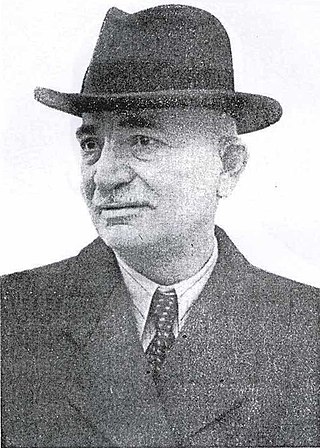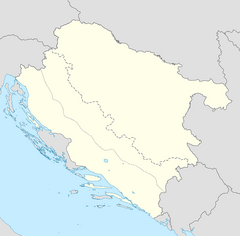The Ustaše, also known by anglicised versions Ustasha or Ustashe, was a Croatian fascist and ultranationalist organization active, as one organization, between 1929 and 1945, formally known as the Ustaša – Croatian Revolutionary Movement. Its members assisted in assassinating King Alexander I of Yugoslavia in 1934, and went on to perpetrate The Holocaust in the Independent State of Croatia, killing hundreds of thousands of Serbs, Jews, Roma as well as Bosniak Muslims and Croatian political dissidents during World War II in Yugoslavia.

Ante Pavelić was a Croatian politician who founded and headed the fascist ultranationalist organization known as the Ustaše in 1929 and served as dictator of the Independent State of Croatia (NDH), a fascist puppet state built out of parts of occupied Yugoslavia by the authorities of Nazi Germany and Fascist Italy, from 1941 to 1945. Pavelić and the Ustaše persecuted many racial minorities and political opponents in the NDH during the war, including Serbs, Jews, Romani, and anti-fascists, becoming one of the key figures of the genocide of Serbs, the Porajmos and the Holocaust in the NDH.

The Independent State of Croatia was a World War II-era puppet state of Nazi Germany and Fascist Italy. It was established in parts of occupied Yugoslavia on 10 April 1941, after the invasion by the Axis powers. Its territory consisted of most of modern-day Croatia and Bosnia and Herzegovina, as well as some parts of modern-day Serbia and Slovenia, but also excluded many Croat-populated areas in Dalmatia, Istria, and Međimurje regions.

Ljubomir "Ljubo" Miloš was a Croatian public official who was a member of the Ustaše of the Independent State of Croatia (NDH) during World War II. He served as commandant of the Jasenovac concentration camp on several occasions and was responsible for various atrocities committed there during the war. He fled Yugoslavia in May 1945 and sought refuge in Austria. In 1947, he returned to Yugoslavia with the intention of starting an anti-communist uprising. He was soon arrested by Yugoslav authorities and charged with war crimes. Miloš was found guilty on all counts and hanged in August 1948.

Vjekoslav Luburić was a Croatian Ustaše official who headed the system of concentration camps in the Independent State of Croatia (NDH) during much of World War II. Luburić also personally oversaw and spearheaded the contemporaneous genocides of Serbs, Jews and Roma in the NDH.

Sekula Drljević was a Montenegrin nationalist, Yugoslav jurist, politician, orator, and theoretician. During World War II, he became a collaborator with Nazi Germany and Fascist Italy, and cooperated with the Ustaše in the German puppet state of Croatia.

The Sajmište concentration camp was a Nazi German concentration and extermination camp during World War II. It was located at the former Belgrade fairground site near the town of Zemun, in the Independent State of Croatia (NDH). The camp was organized and operated by SS Einsatzgruppen units stationed in occupied Serbia. It became operational in September 1941 and was officially opened on 28 October of that year. The Germans dubbed it the Jewish camp in Zemun. At the end of 1941 and the beginning of 1942, thousands of Jewish women, children and old men were brought to the camp, along with 500 Jewish men and 292 Romani women and children, most of whom were from Niš, Smederevo and Šabac. Women and children were placed in makeshift barracks and suffered during numerous influenza epidemics. Kept in squalid conditions, they were provided with inadequate amounts of food and many froze to death during the winter of 1941–42. Between March and May 1942, the Germans used a gas van sent from Berlin to kill thousands of Jewish inmates.

The Grand Anti-Masonic Exhibition was the name of an antisemitic exhibition that was opened on October 22, 1941 during World War II in Belgrade, the capital of the Nazi Germany-established Militärverwaltung in occupied Serbia.

World War II in the Kingdom of Yugoslavia began on 6 April 1941, when the country was invaded and swiftly conquered by Axis forces and partitioned among Germany, Italy, Hungary, Bulgaria and their client regimes. Shortly after Germany attacked the USSR on 22 June 1941, the communist-led republican Yugoslav Partisans, on orders from Moscow, launched a guerrilla liberation war fighting against the Axis forces and their locally established puppet regimes, including the Axis-allied Independent State of Croatia (NDH) and the Government of National Salvation in the German-occupied territory of Serbia. This was dubbed the National Liberation War and Socialist Revolution in post-war Yugoslav communist historiography. Simultaneously, a multi-side civil war was waged between the Yugoslav communist Partisans, the Serbian royalist Chetniks, the Axis-allied Croatian Ustaše and Home Guard, Serbian Volunteer Corps and State Guard, Slovene Home Guard, as well as Nazi-allied Russian Protective Corps troops.

The Genocide of Serbs in the Independent State of Croatia was the systematic persecution of Serbs which was committed during World War II by the fascist Ustaše regime in the Nazi German puppet state known as the Independent State of Croatia between 1941 and 1945. It was carried out through executions in death camps, as well as through mass murder, ethnic cleansing, deportations, forced conversions, and war rape. This genocide was simultaneously carried out with the Holocaust in the NDH as well as the genocide of Roma, by combining Nazi racial policies with the ultimate goal of creating an ethnically pure Greater Croatia.

The Navy of the Independent State of Croatia, was the navy of the Independent State of Croatia, an Axis puppet state controlled by the fascist Ustaše party. The NDH was created from parts of the Kingdom of Yugoslavia on 10 April 1941, four days after the World War II invasion of Yugoslavia by the Axis powers commenced. The RMNDH consisted of two commands, the Coast and Maritime Traffic Command, and the River and River Traffic Command, and had its headquarters in the NDH capital, Zagreb. The Coast and Maritime Traffic Command consisted of three naval commands along the Adriatic coast, which were each divided into a number of naval districts. The naval districts consisted mainly of naval and weather stations, and were only responsible for coast guard and customs duties. The River and River Traffic Command consisted of seven river stations, a naval infantry battalion, and a River Command Flotilla built around two former Yugoslav river monitors, which had been scuttled during the invasion but subsequently refloated.

The Glina massacres were killings of Serb peasants in the town of Glina in the Independent State of Croatia (NDH) that occurred between May and August 1941, during World War II. The first wave of massacres in the town began on 11 or 12 May 1941, when a band of Ustaše led by Mirko Puk murdered a group of Serb men and boys in a Serbian Orthodox church before setting it on fire. The following day, approximately 100 Serb males were murdered by the Ustaše in the nearby village of Prekopi. Estimates of the overall number of Serbs killed from 11 to 13 May range from 260 to 417. Further killings in Glina occurred between 30 July and 3 August of that same year, when 700–2,000 Serbs were massacred by a group of Ustaše led by Vjekoslav Luburić.
The Jastrebarsko children's camp held Serb children who had been brought there from various areas of the Axis puppet state, the Independent State of Croatia, during World War II. The children had been captured as a result of massacres and counter-insurgency operations conducted by the genocidal Ustaše-led government, its Axis allies and other collaborators since the Axis invasion of Yugoslavia and establishment of the NDH in April 1941. The camp was located in the town of Jastrebarsko, about 37 kilometres (23 mi) southwest of the NDH capital, Zagreb, and operated from 12 July until October 1942. Camp administration was provided by nuns of the Daughters of Charity of Saint Vincent de Paul order, with Ustaše guards.

The Holocaust in the Independent State of Croatia involved the genocide of Jews, Serbs and Romani within the Independent State of Croatia, a fascist puppet state that existed during World War II, led by the Ustaše regime, which ruled an occupied area of Yugoslavia including most of the territory of modern-day Croatia, the whole of modern-day Bosnia and Herzegovina and the eastern part of Syrmia (Serbia). Of the 39,000 Jews who lived in the NDH in 1941, the United States Holocaust Memorial Museum states that more than 30,000 were murdered. Of these, 6,200 were shipped to Nazi Germany and the rest of them were murdered in the NDH, the vast majority in Ustaše-run concentration camps, such as Jasenovac. The Ustaše were the only quisling forces in Yugoslavia who operated their own extermination camps for the purpose of murdering Jews and members of other ethnic groups.

Diana Budisavljević was an Austrian humanitarian who led a major relief effort in Yugoslavia during World War II. From October 1941, on her initiative and involving many co-workers, she organized and provided assistance to mostly Serbian Orthodox women and children detained in the Ustaše camps in the Independent State of Croatia, a Nazi puppet state established in occupied Yugoslavia. The operation, known as "Action Diana Budisavljević", succeeded in saving around 10,000 children. After her story was better publicized in the 2000s and 2010s, she received substantial posthumous recognition.
The Ustaše Militia was the military branch of the Ustaše, established by the fascist and genocidal regime of Ante Pavelić in the Independent State of Croatia (NDH), an Axis puppet state established from a large part of occupied Yugoslavia during World War II.

Petar Baćović was a Bosnian Serb Chetnik commander within occupied Yugoslavia during World War II. From the summer of 1941 until April 1942, he headed the cabinet of the Ministry of Internal Affairs for Milan Nedić's puppet Government of National Salvation in the German-occupied territory of Serbia. In May and June 1942, Baćović participated in the joint Italian-Chetnik offensive against the Yugoslav Partisans in Montenegro. In July 1942, Baćović was appointed by the Chetnik leader Draža Mihailović and his Supreme Command as the commander of the Chetnik units in the regions of eastern Bosnia and Herzegovina within the Axis puppet state, the Independent State of Croatia. In this role, Baćović continued collaborating with the Italians against the Yugoslav Partisans, with his Chetniks formally recognised as Italian auxiliaries from mid-1942.
Kruščica was a concentration camp established and operated by the fascist, Croatian nationalist Ustaše movement near the town of Vitez, in the Independent State of Croatia (NDH), between August and October 1941, during World War II.

Đakovo was an internment camp for Jewish, and to a lesser extent Serb, women and children in the town of Đakovo in the Independent State of Croatia (NDH) that was operational between December 1941 and July 1942, during World War II.

During World War II, the Croatian Peasant Party splintered into several factions pursuing different policies and alliances. Prior to the German invasion of Yugoslavia, it was the most powerful political party among ethnic Croats, controlled the administration and police in Banovina of Croatia, and commanded two paramilitary organisations. After the successful invasion of the Kingdom of Yugoslavia in April 1941, Nazi Germany proposed that HSS leader Vladko Maček could rule Croatia as a puppet state. He declined, but the Ustaše agreed and proclaimed the Independent State of Croatia. Under duress, Maček called on Croats to support the regime. A splinter of the HSS and all HSS-controlled infrastructure went over to the Ustaše.



















